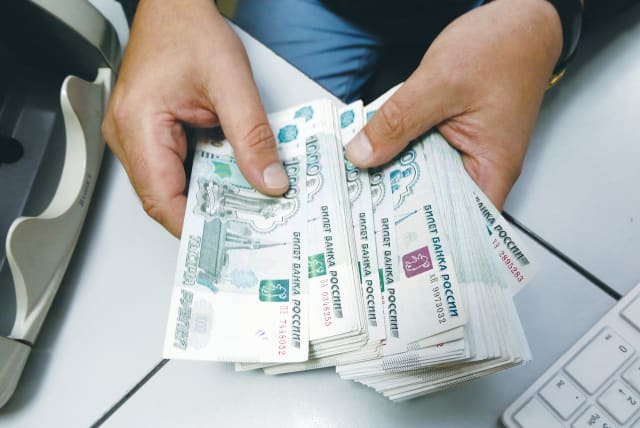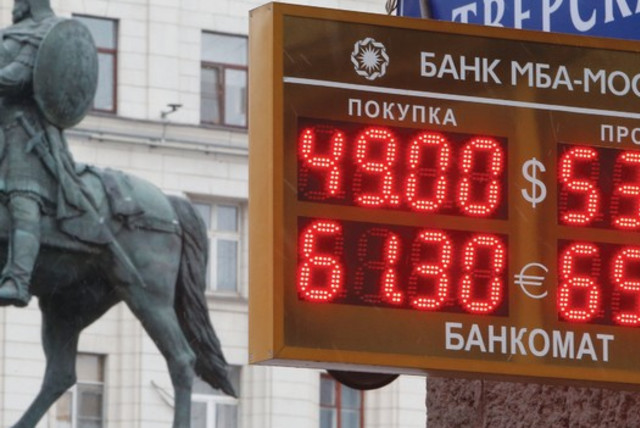How Russia can re-strengthen the ruble - analysis

With its latest decline, the ruble is worth only one US cent. That seems humiliating for the great power that Putin deems Russia to be.
The Russian ruble has touched a key psychological barrier of 100 rubles per one US dollar. Its exchange rate is a mirror in which Russia’s sorry recent history is clearly reflected.
In the Soviet era there was constant talk in Pravda, the Communist Party newspaper, and various Marxist-Leninist economic journals, about the imminent demise of the dollar. Since Marx and Lenin had scientifically predicted the end of capitalism, it logically followed that the dollar should soon collapse.
And in fact the dollar was very sick – at least if you looked at the official ruble exchange-rate that was published daily in one of the Soviet papers. It almost never changed, and the ruble was allegedly worth $1.35, or only around 75 Soviet kopecks per dollar.
It was an excellent rate, but the problem was that you couldn’t just stop at your local branch of the State Savings Bank and exchange your rubles for dollars – or for any other currency for that matter.
And, since the ruble was not traded on any market, the exchange rate was not set by the laws of supply and demand but was arbitrarily decreed by the government.
If you were one of the few lucky Soviets allowed to travel abroad, the government would sell you foreign currency at this rate – but only a tiny amount. On the other hand, if you were an athlete, a musician or any other professional earning money abroad, you were obliged to surrender foreign currency to the government at that same rate – which in this case would turn from highly favorable to confiscatory.
Supply and demand did play a role in setting the dollar exchange rate, but only on the black market, where it could be anywhere between five and 10 rubles per dollar. However, holding foreign currency was a criminal offense. You could be packed off to jail for a long time. In the early 1960s, a group of young wheeler-dealers who bought dollars from foreigners was busted and its three leaders were sentenced to death by firing squad.
When communism collapsed, the inefficiencies of the Soviet command economy became obvious. The system was geared to make tanks and rockets but could produce nothing that people actually wanted to buy – few consumer goods, no consumer electronics, and not even decent or plentiful food. Once currency trading was decriminalized, it was the ruble that crumbled, not the dollar. This created a vicious cycle. The falling ruble led to inflation and inflation further undermined the ruble, creating even more inflation, etc. By the time the situation finally stabilized one dollar was worth 6,000 rubles.
At the start of 1998, the government effected a redenomination, slashing three zeros off the currency. That made the ruble respectable; in fact, it was then at parity with the French franc, with the exchange rate of six rubles per dollar. The problem was that in August of that year (August is a fateful month in the history of modern Russia), a financial crisis broke out and by early 1999 the dollar was worth 25 rubles.
Vladimir Putin's history
Vladimir Putin was appointed Russia’s prime minister in August 1999, which was another August disaster. In the early 2000s, he presided over a major run-up in energy prices that helped Russia achieve unprecedented prosperity. Russia became integrated into the world economy, and even ordinary Russians could travel abroad, flash their appreciating rubles and wonder why Paris, Berlin and London seemed cheap compared to Moscow.
But Putin was pining away for the old Soviet Union, whose collapse he described in 2005 as “the greatest geopolitical catastrophe of the 20th century.” As Russia attacked Georgia, annexed Crimea, and finally, invaded Ukraine, relations with the West soured and Putin’s propaganda machine began turning back to Soviet rhetoric. Russians are now told that the West wants to destroy their country and steal its oil, that American democracy is sham and that Russia is the only country where citizens are truly free.
The imminent demise of the dollar is back as well. Washington is sinking under the burden of debt, dollars are pieces of paper not backed by any real assets, the dollar as the global reserve currency is finished and will soon be worthless.
But it has been the ruble that became worthless. Hand-in-hand with revived Soviet rhetoric came increasing isolation, a worsening business climate and declining foreign investment. Guns were increasingly produced at the expense of butter. Now that Russia has started a full-scale war in Europe and severe Western sanctions have been imposed, the ruble is plumbing the new depths.
With its latest decline, the ruble is worth only one US cent. That seems humiliating for the great power that Putin deems Russia to be. However, the Soviet experience provides not only the prediction of the demise of the greenback, but the remedy as well. All that is needed is for the ruble to stop trading, for the possession of foreign currency to be declared a felony, and for the central bank to set a more respectable exchange rate, something like $1.35 per ruble.
The writer, a New York-based economist, is a member of the US Andrei Sakharov Foundation. In 2005-08, he organized a support group for the Hebrew Immigrant Aid Society, bringing together Soviet Jewish immigrants in the United States.
Jerusalem Post Store
`; document.getElementById("linkPremium").innerHTML = cont; var divWithLink = document.getElementById("premium-link"); if (divWithLink !== null && divWithLink !== 'undefined') { divWithLink.style.border = "solid 1px #cb0f3e"; divWithLink.style.textAlign = "center"; divWithLink.style.marginBottom = "15px"; divWithLink.style.marginTop = "15px"; divWithLink.style.width = "100%"; divWithLink.style.backgroundColor = "#122952"; divWithLink.style.color = "#ffffff"; divWithLink.style.lineHeight = "1.5"; } } (function (v, i) { });

